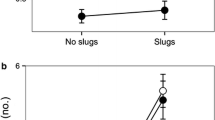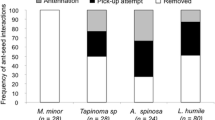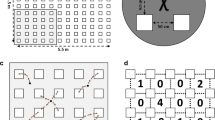Abstract
Myrmecochory (seed dispersal by ants) is a unique seed dispersal syndrome among invertebrates. It comprises three main phases: seed removal, seed manipulation, and seed deposition. However, the contribution of each phase to seed and seedling fate remains unclear. Here, we experimentally quantified the effects of each phase of myrmecochory on seed germination and seedling establishment, the two most critical life history stages involved in plant recruitment. We established 30 sample points, and each included an adult Mabea fistulifera tree, an Atta sexdens nest entrance, and six seed depots. We monitored the germination of M. fistulifera seeds for 3 months and subsequently followed the growth and mortality of the resulting seedlings for 12 months. Only the dispersal distance influenced plant establishment, reducing seed germination and increasing seedling growth, but with no effect of seed manipulation and deposition site. Despite the contrasting effects of distance on seed germination and seedling growth, the positive effect of dispersal distance on seedling growth was ten times greater than the negative effect on seed germination. Moreover, A. sexdens behaved neither as granivore nor as herbivore of M. fistulifera seeds or seedlings, which suggests that seed dispersal by A. sexdens is advantageous to M. fistulifera. Thus, the joint occurrence of these two species in disturbed areas could have a positive effect on this pioneer plant population, which might promote forest regeneration.





Similar content being viewed by others
References
Andersen AN (1988) Dispersal distance as a benefit of myrmecochory. Oecologia 75:507–511. https://doi.org/10.1007/BF00776412
AntWeb (2019). http://www.antweb.org. Accessed 20 Jan 2019
Arène F, Affre L, Doxa A, Saatkamp A (2018) Temperature but not moisture response of germination shows phylogenetic constraints while both interact with seed mass and lifespan. Seed Sci Res 27:110–120. https://doi.org/10.1017/s0960258517000083
Bates D, Maechler M, Bolker B, Walker S (2016) lme4: linear mixed-effects models using “Eigen” and S4. R Package Version 1.1-12. R
Bello C, Galetti M, Montan D et al (2017) Atlantic frugivory: a plant–frugivore interaction data set for the Atlantic Forest. Ecology 98:1729. https://doi.org/10.1002/ecy.1818
Boyd RS (2001) Ecological benefits of myrmecochory for the endangered chaparral shrub Fremontodendron decumbens (Sterculiaceae). Am J Bot 88:234–241. https://doi.org/10.2307/2657014
Carvalho B, Ribeiro SP (2018) Architecture of Mabea fistulifera Mart. (Euphorbiaceae), a neotropical semideciduous tree: development and variations in crown allometry between environments. Flora 239:104–110. https://doi.org/10.1016/j.flora.2017.12.003
Castro S, Ferrero V, Loureiro J et al (2010) Dispersal mechanisms of the narrow endemic Polygala vayredae: dispersal syndromes and spatio-temporal variations in ant dispersal assemblages. Plant Ecol 207:359–372. https://doi.org/10.1007/s11258-009-9679-z
Comita LS, Muller-Landau HC, Aguilar S, Hubbell SP (2010) Asymmetrie density dependence shapes species abundances in a tropical tree community. Science 329:330–332. https://doi.org/10.1126/science.1190772
Comita LS, Queenborough SA, Murphy SJ et al (2014) Testing predictions of the Janzen-Connell hypothesis: a meta-analysis of experimental evidence for distance- and density-dependent seed and seedling survival. J Ecol 102:845–856. https://doi.org/10.1111/1365-2745.12232
Condamine FL, Clapham ME, Kergoat GJ (2016) Global patterns of insect diversification: towards a reconciliation of fossil and molecular evidence? Sci Rep 6:1–13. https://doi.org/10.1038/srep19208
Connell JH (1971) On the role of natural enemies in preventing competitive exclusion in some marine animals and in rain forest trees. Dyn Popul 298:312
Crawley JM (2013) The R book, second. Wiley, Chichester
Culver D, Beattie A (1980) The fate of Viola seeds dispersed by ants. Am J Bot 67:710–714. https://doi.org/10.2307/2442664
Dalling JW, Winter K, Hubbell SP (2004) Variation in growth responses of neotropical pioneers to simulated forest gaps. Funct Ecol 18:725–736. https://doi.org/10.1111/j.0269-8463.2004.00868.x
Dirzo R, Young HS, Galetti M et al (2014) Defaunation in the anthropocene. Science 345:401–406. https://doi.org/10.1126/science.1251817
EMBRAPA (Empresa Brasileira De Pesquisa Agropecuaria) (1997) Manual de métodos de análise de solo, 2nd edn. CNPS, Rio de Janeiro
Farji-Brener AG, Werenkraut V (2015) A meta-analysis of leaf-cutting ant nest effects on soil fertility and plant performance. Ecol Entomol 40:150–158. https://doi.org/10.1111/een.12169
Farji-Brener AG, Werenkraut V (2017) The effects of ant nests on soil fertility and plant performance: a meta-analysis. J Anim Ecol 86:866–877. https://doi.org/10.1111/1365-2656.12672
Farrell BD, Mitter C, Futuyma DJ (1992) Diversification at the plant–insect interface: insights from phylogenetics. Bioscience 42:34–42
Farwig N, Berens DG (2012) Imagine a world without seed dispersers: a review of threats, consequences and future directions. Basic Appl Ecol 13:109–115. https://doi.org/10.1016/j.baae.2012.02.006
Fernandes TV, Paolucci LN, Carmo FMS et al (2018) Seed manipulation by ants: disentangling the effects of ant behaviours on seed germination. Ecol Entomol 43:712–718. https://doi.org/10.1111/een.12655
Filomeno CA, Barbosa LCA, Pereira JL et al (2016) The chemical diversity of Eucalyptus spp. essential oils from plants grown in Brazil. Chem Biodivers 13:1656–1665. https://doi.org/10.1002/cbdv.201600097
Frazer S, Canham CD, Lertzman K (1999) Gap light analyzer (GLA). Users manual and programme documentation, Version 2.0
Giladi I (2006) Choosing benefits or partners: a review of the evidence for the evolution of myrmecochory. Oikos 112:481–492. https://doi.org/10.1111/j.0030-1299.2006.14258.x
Gómez C, Espadaler X (2013) An update of the world survey of myrmecochorous dispersal distances. Ecography (Cop) 36:1193–1201. https://doi.org/10.1111/j.1600-0587.2013.00289.x
Guerra TJ, Messeder JVS, Arruda AJ et al (2018) Handling by avian frugivores affects diaspore secondary removal. PLoS One. https://doi.org/10.1371/journal.pone.0202435
Handel SN (1976) Dispersal ecology of Carex pedunculata (Cyperaceae), a New North American Myrmecochore. Am J Bot 63:1071. https://doi.org/10.2307/2441651
Hölldobler B, Wilson EO (1990) The Ants. University Press, Cambridge, MA
Horvitz CC (1981) Analysis of how ant behaviors affect germination in a tropical myrmecochore Calathea microcephala (P. & E.) Koernicke (Marantaceae): microsite selection and aril removal by neotropical ants, Odontomachus, Pachycondyla, and Solenopsis (Formicidae). Oecologia 51:47–52. https://doi.org/10.1007/BF00344651
Hougart P (1995) Frailty models for survival data. Lifetime data analysis, 1st edn. Springer, New York
Howe HF, Smallwood J (1982) Ecology of Seed Dispersal. Annu Rev Ecol Syst 13:201–228. https://doi.org/10.1146/annurev.es.13.110182.001221
Hu S, Dilcher DL, Jarzen DM, Winship Taylor D (2008) Early steps of angiosperm pollinator coevolution. Proc Natl Acad Sci 105:240–245. https://doi.org/10.1073/pnas.0707989105
Hurtado A, Escobar S, Marina Torres A, Armbrecht I (2012) Exploring the role of the generalist ant Solenopsis geminata (Formicidae: Myrmicinae) on seed germination of Senna spectabilis (Fabaceae: Caesalpinioideae). Caldasia 34:127–137
Imbert E (2006) Dispersal by ants in Centaurea corymbosa (Asteraceae): what is the elaiosome for? Plant Species Biol 21:109–117. https://doi.org/10.1111/j.1442-1984.2006.00156.x
Kjellsson G (1991) Seed fate in an ant-dispersed sedge, Carex pilulifera L.: recruitment and seedling survival in tests of models for spatial dispersion. Oecologia 88:435–443
Kobe RK (1999) Light gradient partitioning among tropical tree species through differential seedling mortality and growth. Ecology 80:187–201
Kyereh B, Swaine MD, Thompson J (1999) Effect of light on the germination of forest tree seeds. J Ecol 87:772–783
Leal IR, Oliveira PS (1998) Interactions between fungus-growing ants (Attini), fruits and seeds in Cerrado vegetation in southeast Brazil. Biotropica 30:170–178. https://doi.org/10.1111/j.1744-7429.1998.tb00052.x
Leal IR, Wirth R, Tabarelli M (2007) Seed dispersal by ants in the semi-arid caatinga of north-east Brazil. Ann Bot 99:885–894. https://doi.org/10.1093/aob/mcm017
Leal IR, Wirth R, Tabarelli M (2014) The multiple impacts of leaf-cutting ants and their novel ecological role in human-modified neotropical forests. Biotropica 46:516–528. https://doi.org/10.1111/btp.12126
Lengyel S, Gove AD, Latimer AM et al (2009) Ants sow the seeds of global diversification in flowering plants. PLoS One 4:1–6. https://doi.org/10.1371/journal.pone.0005480
Levin SA, Muller-Landau HC, Nathan R, Chave J (2003) The ecology and evolution of seed dispersal: a theoretical perspective. Annu Rev Ecol Evol Syst 34:575–604. https://doi.org/10.1146/annurev.ecolsys.34.011802.132428
Liland KH (2018) mixlm: mixed model ANOVA and statistics for education. R Package Version 1.2.3
Lorenzi H (2002) Árvores brasileiras: manual de identificação e cultivo de plantas arbóreas nativas do Brasil, 4 th. Plantarum, Nova Odessa
Madureira MS, Schoereder JH, Teixeira MC, Sobrinho TG (2013) Why does Atta robusta (Formicidae) not change soil features around their nests as other leaf-cutting ants do? Soil Biol Biochem 57:916–918. https://doi.org/10.1016/j.soilbio.2012.11.005
Magalhães VB, Espírito Santo NB, Salles LFP et al (2018) Secondary seed dispersal by ants in Neotropical cerrado savanna: species-specific effects on seeds and seedlings of Siparuna guianensis (Siparunaceae). Ecol Entomol 43:665–674. https://doi.org/10.1111/een.12640
May RM (2010) Tropical arthropod species, more or less? Science 329:41–42. https://doi.org/10.1126/science.1191058
Ohkawara K, Akino T (2005) Seed cleaning behavior by tropical ants and its anti-fungal effect. J Ethol 23:93–98. https://doi.org/10.1007/s10164-004-0132-4
Padilla DP, González-Castro A, Nogales M (2012) Significance and extent of secondary seed dispersal by predatory birds on oceanic islands: the case of the Canary archipelago. J Ecol 100:416–427. https://doi.org/10.1111/j.1365-2745.2011.01924.x
Passos L, Ferreira SO (1996) Ant dispersal of Croton priscus (Euphorbiceae) seeds in an tropical semideciduous forest in Southeastern Brazil. Biotropica. https://doi.org/10.2307/2389055
Peel MC, Finlayson BL, McMahon TA (2007) Updated world map of the Köppen-Geiger climate classification. Hydrol Earth Syst Sci Discuss 4:439–473. https://doi.org/10.5194/hessd-4-439-2007
Pérez-Méndez N, Jordano P, García C, Valido A (2016) The signatures of anthropocene defaunation: cascading effects of the seed dispersal collapse. Sci Rep 6:1–9. https://doi.org/10.1038/srep24820
Peternelli EFDO, Della Lucia TMC, Martins SV (2004) Espécies de formigas que interagem com as sementes de Mabea fistulifera Mart. (Euphorbiaceae). Rev Árvore 28:733–738. https://doi.org/10.1590/S0100-67622004000500013
Peternelli EFO, Delia Lucia TMC, Peternelli LA, Moreira NC (2009) Seed transport and removal of the elaiosome of Mabea fistulifera by workers of Atta sexdens rubropilosa (Hymenoptera: Formicidae). Sociobiology 53:275–290
Prior KM, Saxena K, Frederickson ME (2014) Seed handling behaviours of native and invasive seed-dispersing ants differentially influence seedling emergence in an introduced plant. Ecol Entomol 39:66–74. https://doi.org/10.1111/een.12068
R Core Team (2016) R development core team. R A Lang Environ Stat Comput 55:275–286
R Core Team (2019) R: a language and environment for statistical computing. R Foundation for Statistical Computing, Vienna, Austria. https://www.R-project.org/
Rüger N, Wirth C, Wright SJ, Condit R (2012) Functional traits explain light and size response of growth rates in tropical tree species. Ecology 93:2626–2636
Schupp EW (1995) Seed–seedling conflicts, habitat choice, and patterns of plant recruitment. Am J Bot 82:399–409. https://doi.org/10.2307/2445586
Schupp EW, Jordano P, Gómez JM (2010) Seed dispersal effectiveness a conceptual review. New Phytol 188:333–353. https://doi.org/10.1111/j.1469-8137.2010.03402.x
Servigne P, Detrain C (2010) Opening myrmecochory’s black box: what happens inside the ant nest? Ecol Res 25:663–672. https://doi.org/10.1007/s11284-010-0700-8
Silva CA, Vieira MF, Do Amaral CH (2010) Floral attributes, ornithophily and reproductive success of Palicourea longepedunculata (Rubiaceae), a distylous shrub in southeastern Brazil. Rev Bras Botânica 33:207–213. https://doi.org/10.1590/S0100-84042010000200002
Svenning J-C, Pedersen PBM, Donlan CJ et al (2016) Science for a wilder Anthropocene: synthesis and future directions for trophic rewilding research. Proc Natl Acad Sci 113:898–906. https://doi.org/10.1073/pnas.1502556112
Tanaka K, Tokuda M (2016) Seed dispersal distances by ant partners reflect preferential recruitment patterns in two ant-dispersed sedges. Evol Ecol 30:943–952. https://doi.org/10.1007/s10682-016-9846-3
Therneau TM, Lumley T (2016) Survival: survival analysis. R Packag version 239–4:128. https://doi.org/10.1016/j.jhydrol.2011.07.022
Tymen B, Vincent G, Courtois EA et al (2017) Quantifying micro-environmental variation in tropical rainforest understory at landscape scale by combining airborne LiDAR scanning and a sensor network. Ann For Sci. https://doi.org/10.1007/s13595-017-0628-z
van der Pijl L (1982) Principles of dispersal in higher plants, 3rd edn. Springer, New York
Wills BD, Landis DA (2018) The role of ants in north temperate grasslands: a review. Oecologia 186:323–338. https://doi.org/10.1007/s00442-017-4007-0
Wirth R, Meyer ST, Almeida WR et al (2007) Increasing densities of leaf-cutting ants (Atta spp.) with proximity to the edge in a Brazilian Atlantic forest. J Trop Ecol 23:501–505. https://doi.org/10.1017/S0266467407004221
Acknowledgements
This article was part of TVF's master thesis that was funded by the Fundação de Amparo a Pesquisa de Minas Gerais (FAPEMIG) and by the Programa de Pós-graduação em Ecologia from the Universidade Federal de Viçosa (UFV), and LNP was supported by a Coordenação de Aperfeiçoamento de Pessoal de Nível Superior (PNPD/CAPES) grant. We are grateful for financial support from Pesquisa & Desenvolvimento of Agência Nacional de Energia Elétrica and Companhia Energética de Minas Gerais (P&D ANEEL/CEMIG, PROECOS project GT-599), FAPEMIG (APQ-01424-15) and CNPq (428298/2018-4) research project grants. We are also grateful to O.L. Fernandes, R. Silva Dos Santos, M. M. Maia, and V. C. Rocha for help with fieldwork, to the Departamento de Engenharia Florestal (UFV) for allowing access to the study site, to Della Lucia’s laboratory for lending us their ant colonies, to Tatiana Cornelissen and Paulo Peixoto for help with statistical analysis, to Alexander Christianini for some good advices on the experimental design and finally to two anonymous reviewers for their helpful comments.
Author information
Authors and Affiliations
Contributions
TVF, RRCS, and RIC conceived and designed the experiments. TVF performed the experiments. TVF, RRCS, and RIC analysed the data. All other authors contributed substantially to writing the manuscript and provided editorial advice.
Corresponding author
Ethics declarations
Conflict of interest
All authors declare they have made a crucial scientific contribution to the study and that they have no conflict of interest. The authors also confirm that all parts of this work comply with the current research laws of Brazil.
Additional information
Communicated by Caroline Müller.
Electronic supplementary material
Below is the link to the electronic supplementary material.
Rights and permissions
About this article
Cite this article
Fernandes, T.V., Paolucci, L.N., Solar, R.R.C. et al. Ant removal distance, but not seed manipulation and deposition site increases the establishment of a myrmecochorous plant. Oecologia 192, 133–142 (2020). https://doi.org/10.1007/s00442-019-04551-5
Received:
Accepted:
Published:
Issue Date:
DOI: https://doi.org/10.1007/s00442-019-04551-5




